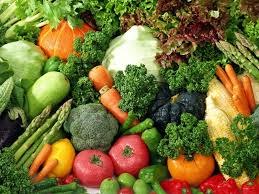
Certain pesticides have a proven link to specific cancers in children and adults. Eating organic food may help to decrease our risk of being diagnosed with cancer.
Non-Hodgkin lymphoma is more common in farmers, pesticide applicators, pesticide factory workers, landscapers, lumberjacks and golf course superintendents.[i] A study of 155,000 farmers found an increased susceptibility to Non-Hodgkin lymphoma after exposure to pesticides, proportional to the number of acres sprayed.[ii] A Canadian study demonstrated a link between exposure to the weed-killers dicamba and methoprop, the insecticide carbamate, and Non-Hodgkin lymphoma.[iii]
Two studies have found a link between elevated leukemia rates and livestock farmers.[iv] Increased rates of all types of leukemia were found in children whose parents used insecticides in the garden and on indoor plants and whose mothers had been exposed while pregnant.[v] Indeed, the most critical exposure period for later development of leukemia is when the fetus is exposed in utero.[vi]
Several studies show an association between pesticide exposure and brain cancer.[vii] Children whose parents were exposed to pesticides at work experience an increased risk.[viii]
Breast cancer can also be linked to pesticide use. An increase risk of breast cancer was specifically found with high exposure to triazine herbicides, including atrazine.[ix] A higher incidence of stomach cancer was also found in areas with elevated atrazine contamination in the water.[x]
In one US study of 55,000 men who applied pesticides, an increased rate of prostate cancer was prevalent, especially in those with a family history of prostate cancer, and those who were exposed to methyl bromide.[xi]
An association has been found between pesticide exposure and kidney and pancreatic cancer.[xii] [xiii]
Given the numerous studies linking pesticide exposure to a variety of cancers, and that exposure in utero can increase risk later in life, it is advisable that we reduce or eliminate exposure across all age groups. Many individuals find it challenging to afford the higher cost of organically grown food. One way to decrease exposure is to grow more of our own food in backyard or community gardens, or participate in a local food co-op.
The Environmental Working Group in the US analyzed pesticide residues of 48 different fruits and vegetables and ranked them as most or least contaminated. The following chart is a guideline to understanding which foods are most contaminated and should be purchased organically grown, and which have fewer pesticides and are safer to consume when not organically grown.[xiv]
| Most Contaminated Foods | Least Contaminated Foods |
| 1. apples | 1. avocado |
| 2. strawberries | 2. sweet corn |
| 3. grapes | 3. pineapple |
| 4. celery | 4. cabbage |
| 5. peaches | 5. frozen sweet peas |
| 6. spinach | 6. onions |
| 7. sweet bell peppers | 7. asparagus |
| 8. imported nectarines | 8. mango |
| 9. cucumbers | 9. papaya |
| 10 cherry tomatoes | 10. kiwi |
| 11 snap peas | 11. eggplant |
| 12. potatoes | 12. grapefruit |
| 13. hot peppers | 13. canteloupe |
| 14. domestic blueberries | 14. cauliflower |
| 15. lettuce | 15. sweet potatoes |
Food Tip: Eat organically grown food as much as possible.
[i] Bassil KL, Vakil C, Sanborn M, Cole DC, Kaur JS, Kerr KJ. Cancer health effects of pesticides: Systematic review. Canadian Family Physician October 2007 vol. 53 no. 10 1704-1711
[ii] Morrison HI, Semenciw RM, Wilkins K, Mao Y, Wigle DT. Non-Hodgkin’s lymphoma and agricultural practices in the prairie provinces of Canada. Scand J Work Envi
[iii] McDuffie HH, Pahwa P, McLaughlin JR, Spinelli JJ, Fincham S,Dosman JA, et al. Non-Hodgkin’s lymphoma and specific pesticide exposures in men: cross-Canada study of pesticides and health. Cancer Epidemiol Biomarkers Prev 2001;10:1155–63.
[iv] Infante-Rivard C, Labuda D, Krajinovic M, Sinnett . Risk of childhood leukemia associated with exposure to pesticides and with gene polymorphisms. Epidemiology 1999;10:481–
[v] Infante-Rivard C, Labuda D, Krajinovic M, Sinnett D. Risk of childhood leukemia associated with exposure to pesticides and with gene polymorphisms. Epidemiology 1999;10:481-7.
[vi] Ma X, Buffler PA, Gunier RB, Dahl G, Smith MT, Reinier K, et al. Critical windows of exposure to household pesticides and risk of childhood leukemia. Environ Health Perspect 2002;110:955-60.
[vii] Davis JR, Brownson RC, Garcia R, Bentz BJ, Turner A. Family pesticide use and childhood brain cancer. Arch Environ Contam Toxicol1993;24:87-92.
[viii] Kristensen P, Andersen A, Irgens LM, Bye AS, Sundheim L. Cancer in offspring of parents engaged in agricultural activities in Norway: incidence and risk factors in the farm environment. Int J Cancer1996;65(1):39-50.
[ix] Kettles MK, Browning SR, Prince TS, Horstman SW. Triazine herbicide exposure and breast cancer incidence: an ecologic study of Kentucky counties. Environ Health Perspect 1997;105:1222-7.
[x] Van Leeuwen JA, Waltner-Toews D, Abernathy T, Smit B, Shoukri M. Associations between stomach cancer incidence and drinking water contamination with atrazine and nitrate in Ontario (Canada) agroecosystems, 1987–1991
[xi] Alavanja MC, Samanic C, Dosemeci M, Lubin J, Tarone R, Lynch CF,et al. Use of agricultural pesticides and prostate cancer risk in the agricultural health study cohort
[xii] Buzio L, Tondel M, De Palma G, Buzio C, Franchini I, Mutti A, et al. Occupational risk factors for renal cell cancer. An Italian case-control study. Medicina del Lavoro 2002;93:303-9.
[xiii] Alguacil J, Kauppinen T, Porta M, Partanen T, Malats N, Kogevinas M,et al. Risk of pancreatic cancer and occupational exposures in Spain. PANKRAS II Study Group



